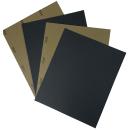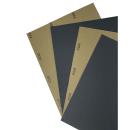Water-based abrasive paper for bodywork

Water-based abrasive paper for cars and motorbikes
-
 FA230-0220Waterproof abrasive sheetsP220 grit - 230x280mm
FA230-0220Waterproof abrasive sheetsP220 grit - 230x280mm -
 FA230-xxxxWaterproof abrasive sheets230 x 280mm - box of 100
FA230-xxxxWaterproof abrasive sheets230 x 280mm - box of 100
︾
Introduction to water-based abrasive papers for your refinishing work:
The importance of water-based abrasive paper
When you're doing bodywork, you quickly realise that sanding paper is very important for a clean, precise end result on your vehicle. However, this kind of result can only be achieved with professional quality, hard-wearing equipment. Carross has selected the best products for wet sanding putties, undercoats, paints and Clearcoats for car bodywork. Waterproof abrasive sheets are flexible and highly resistant, and are generally coated with a layer of latex to make them completely waterproof. Offered at the best prices by our shop, Carross water-based paper is available in the standard 230 x 280 mm format, from 320 grit to 2500 grit for a perfect finish on the bodywork. Selected from the 4CR brand range, your car's bodywork will be more resplendent thanks to our bodywork equipment and our advice!
Definition of water-based abrasive paper
Water-based abrasive paper is a material suitable for bodywork. Depending on the grit you choose, it can be used to roughen or finish the area you want to touch up. But of course, you need to know which type of abrasive material is best suited to bodywork. Abrasive paper, or sandpaper, can be made from flint, emery, garnet or glass. There are also synthetic components such as aluminium oxide or silicon carbide. Abrasive paper is categorised by grain: the system is the same as you would find for an abrasive disc, for example.
Choosing the right water-based abrasive paper
Choosing the right water-based abrasive paper is a question of grit! The right grit depends on the task you have to perform. The papers we list are versatile, allowing you to use them for a variety of purposes, whether you need to work by hand or with a sander. Our site includes sanding papers with many different grits to suit all your uses. Carross stocks large grits such as P80 through to P2500. Whether you need to sand putties, Clearcoats, undercoats or paints, your bodywork will be perfect!
What's the difference between dry and wet sanding paper?
Wet sanding and dry sanding are complementary processes. Dry sanding is generally used before wet sanding. This ensures an even finish. The main purpose of wet sanding is to remove the large marks caused by dry sanding. While dry sanding represents the bulk of bodywork work, wet sanding reduces scratches and makes them smaller and smaller, until they are no longer visible. Wet" sanding refers to the use of water or another liquid as a lubricant to help remove sand particles. If no liquid is used, dust can accumulate on the paper leaving new marks, which can spoil the finish. The wet sanding paper offered by Carross ranges from 220 to 2500 grit and the dry sanding paper varies from extra fine to ultra fine. You can find our dry abrasive paper at this address.
Safety before using water-based abrasive paper
Before using bodywork tools, you need to protect your body! Sanding paper itself carries its share of risks. Admittedly, the dangers are less than when using an Abrasive discs with a sander. But hands, eyes and lungs can still be affected. That's why it's important to use protective gloves, goggles and a mask to protect the lungs. Never take health matters lightly! Carross also offers a range of personal protection equipment.
Other types of abrasives
Carross offers more than just abrasive paper! You'll also find our Abrasive discs, abrasive rollers and universal sanding discs. That's not all we have, and we're here to help you choose the perfect sanding equipment for your bodywork! Our aim is simple: to give you the best possible car paint finish. To do this, don't hesitate to call our sales department or send us a message directly on this page. The entire Carross team is ready to listen and react!
Advantages of using water-based abrasive papers:
The use of water-based abrasive papers is a technique commonly employed in various sanding jobs, particularly in the automotive bodywork sector. This type of abrasive paper is designed to be used with water for a number of reasons, including reducing the heat generated, minimising dust and obtaining a smooth, uniform surface. Here are some details on the use of water-based abrasive papers:
Reduced heat :
Using water during Sanding reduces the heat generated by friction, which can prevent surface damage or melting of heat-sensitive materials.
Dust minimisation:
Water-based abrasive papers generate less dust compared to their dry counterparts, providing a cleaner working environment and reducing the health risks associated with inhaling abrasive dust.
Better lubrication:
Water acts as a lubricant, extending the life of the abrasive paper by minimising its clogging with abrasive particles.
Smoother surface:
The addition of water helps create a smoother surface by removing dust particles and facilitating the movement of the abrasive paper across the surface.
Steps for using water-based abrasive papers :
Prepare the surface:
Make sure the surface to be sanded is clean and free of dirt. Wash it if necessary to remove contaminants.
Choice of grit :
Select the appropriate grit according to the stage of Sanding. Coarser grits are used for initial sanding, while finer grits are suitable for finishing.
Soak the sanding paper:
Immerse the sanding paper in clean water for a few minutes to saturate it and allow better adhesion to the surface.
Sanding with regular strokes:
Use back-and-forth or circular movements, exerting moderate pressure and keeping the surface constantly damp. Reapply water as required.
Regular cleaning:
Clean the surface regularly to remove residue and dust particles. This will also make it easier to see how the sanding is progressing.
Check the surface:
After sanding, check that the surface is smooth and even. If necessary, switch to finer grits for a more polished finish.
Final cleaning:
Remove all dust and residue generated during Sanding. This is particularly important before applying any coatings or paint.
Common applications for water-based abrasive papers:
Water-based abrasive papers are commonly used for surface preparation prior to painting, sanding putty, levelling Topcoats, and other finishing jobs requiring a smooth surface.
By using water-based abrasive papers correctly, you can achieve effective sanding results while preserving the quality of the surface being worked. Choosing the right grit, maintaining adequate lubrication and regularly cleaning the surface are essential for optimum performance.
Frequently asked questions about water-based abrasive papers:
Users often have essential questions about using water-based abrasive paper, looking to optimise their technique to achieve impeccable results in their automotive bodywork projects. Here's an exploration of common questions asked by users, along with informative answers to guide them in their use of water-based abrasive paper:
1. What is the main difference between wet and dry abrasive paper?
The main difference is that water is used as a lubricant during sanding with water-based sanding paper, which reduces heat and dust and contributes to a smoother surface.
2. When should I choose wet sanding paper over dry sanding paper?
Water-based abrasive paper is preferable when you want to minimise dust, reduce the heat generated during sanding, and achieve a smoother finish. It is particularly useful for finishing work.
3. Do I always have to soak the sanding paper in water before using it?
We recommend soaking sanding paper in water before use. This makes it more flexible, prolongs its life and ensures better adhesion to the surface.
4. Can I use water-based abrasive paper on all types of surface?
Yes, water-based abrasive paper is versatile and can be used on a variety of materials such as metal, wood, plastic and car bodywork. Choose the appropriate grit to suit the specific surface.
5. Do I need to use water constantly when sanding with water-based abrasive paper?
Yes, keeping the surface constantly damp improves sanding efficiency by reducing heat and preventing clogging of the sanding paper.
6. Is wet abrasive paper suitable for dry sanding?
Some water-based abrasive papers can be used dry, but they are generally more effective with the addition of water. Dry use can lead to premature wear.
7. How can I minimise wear marks on the bodywork when Sanding with water?
Use moderate pressure, regular strokes and avoid staying in one place for too long. Change the water regularly to keep the surface clean.
8. What is the best grit for initial sanding with water-based abrasive paper?
For initial sanding, choose a coarser grit (40-80) to remove imperfections quickly and prepare the surface for subsequent sanding steps.
By understanding these answers to frequently asked questions, users can effectively exploit the potential of water-based sanding paper, ensuring optimum sanding results and quality surface preparation. Selecting the right grit, maintaining adequate lubrication, and following good Sanding practices will all contribute to a successful bodywork job.